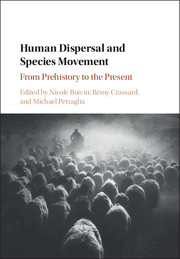Book contents
- Frontmatter
- Contents
- List of text boxes
- List of figures
- List of tables
- List of contributors
- Preface
- I Introduction
- II Origins: Species Movements in the Pleistocene
- III Across the water: Species movements by Coast and Sea
- IV Complexity: Species Movements in the Holocene
- V Invasion: The Movement of Invasive and Disease Species
- 15 Invasive eusocieties: Commonalities between ants and humans
- 16 Invasives, aliens, and labels long forgotten: Toward a semiotics of human-mediated species movement
- 17 Multiple time scales for dispersals of bacterial disease over human history
- 18 Early malarial infections and the first epidemiological transition
- 19 The globalisations of disease
- 20 Modern day population, pathogen and pest dispersals
- Index
- Plate section
- References
17 - Multiple time scales for dispersals of bacterial disease over human history
from V - Invasion: The Movement of Invasive and Disease Species
Published online by Cambridge University Press: 04 May 2017
- Frontmatter
- Contents
- List of text boxes
- List of figures
- List of tables
- List of contributors
- Preface
- I Introduction
- II Origins: Species Movements in the Pleistocene
- III Across the water: Species movements by Coast and Sea
- IV Complexity: Species Movements in the Holocene
- V Invasion: The Movement of Invasive and Disease Species
- 15 Invasive eusocieties: Commonalities between ants and humans
- 16 Invasives, aliens, and labels long forgotten: Toward a semiotics of human-mediated species movement
- 17 Multiple time scales for dispersals of bacterial disease over human history
- 18 Early malarial infections and the first epidemiological transition
- 19 The globalisations of disease
- 20 Modern day population, pathogen and pest dispersals
- Index
- Plate section
- References
Summary
Abstract
Multiple microbial pathogens have spread geographically, sometimes with drastic impacts on the health of humans and their domesticated animals and crops due to epidemic outbreaks of disease. However, microbial pathogens do not leave fossils, and, until very recently, it has been difficult to reconstruct the causes of historical human diseases. For some bacterial pathogens, this situation is now changing due to recent advances in population genetics, DNA sequencing, and ancient DNA studies. This chapter illustrates these developments with an overview of the histories of three exemplary bacterial pathogens: Helicobacter pylori (a common cause of gastric ulcers), Yersinia pestis (the cause of plague), and Salmonella enterica serovar Agona (a common cause of gastroenteritis), with occasional references to other bacteria. These three pathogens have been inferred to have infected humans for very different time periods within the history of anatomically modern humans, ranging from 100,000 years down to 80 years.
Keywords: History of disease, molecular clock rates, bacterial populations, human migrations, geographic diversity
MOLECULAR CLOCK RATES
In 1654, James Usher (Ussher), Church of Ireland Archbishop of Armagh and Primate of all Ireland, calculated that the world began on the night preceding Sunday, 23 October 4004 BC http://en.wikipedia.org/wiki/James_Ussher). This calculation is notable both for its supposed precision, and for the fact that it is still believed by some Creationists http://en.wikipedia.org/wiki/Young_earth_creationism). However, scientific analyses support very different estimates of the age of various historical events (Table 17.1).
Until several years ago, it was generally believed by microbiologists that bacteria accumulate mutations at a constant molecular clock rate of 3.4∙10−9 mutations per nucleotide per year, which was based on an estimate that the bacterial species Escherichia coli and S. enterica separated about 160 million years ago (Ochman and Wilson 1987). This clock rate then allowed calculating the ages of other bacterial taxa based on their genetic diversity, resulting in estimates of 70 million years for the age of Moraxella catarrhalis (Wirth et al. 2007), 50,000 years for S. enterica serovar Typhi (Kidgell et al. 2002), and 7,000 years for E. coli O157:H7 (Leopold et al. 2009). However, these estimates of the ages of bacterial pathogens are suspect, as are all others predating 2008, because protein-coding genes mutate at different rates in different taxa (Ochman et al. 1999), and the original calibrations supporting a constant clock rate are no longer valid (Morelli et al. 2010a).
- Type
- Chapter
- Information
- Human Dispersal and Species MovementFrom Prehistory to the Present, pp. 454 - 476Publisher: Cambridge University PressPrint publication year: 2017
References
- 4
- Cited by

